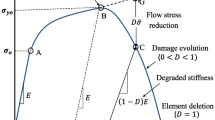Abstract
A transient, full three-dimensional mathematical model that describes the ablation phenomena, the thermal stress evolution, and the failure process that occur during laser cutting or forming operations on ceramic plates is developed. The model development is based on the finite element simulation of thermal field and stress development during laser cutting or forming operations. To treat the ablation phenomena during laser cutting, a fixed-grid algorithm is applied to handle complex ablation geometries with discontinuities. This algorithm is essential for applications to multiple-laser cutting operations. The thermal and stress evolution model is further integrated with a probabilistic fracture model to assess the failure probability during both laser cutting and forming processes. Numerical results show that the groove shapes as well as the temperature and stress distributions are similar in front of the cutting laser for both single and dual lasers but differ in the region when the lead laser becomes effective in dual-beam machining.
Similar content being viewed by others
References
G. Chryssolouris, G. Anifantis, and N.S. Karagiannis: “Laser Assisted Machining: An Overview,” J. Manuf. Sci. Eng., 1997, 119(4B), pp. 766–69.
T.K. McDermott, J. Tillotson, Jr., and R.C. Phoenix: “Thick and Thin Film Manufacturers Find Laser Machining Cost Effective,” Hybrid Circuit Technol., 1988, 5(9), pp. 20–21.
J. Powell: CO 2 Laser Cutting, Springer, London, 1988.
I. Black: “Laser Cutting Speeds for Ceramic Tile: A Theoretical-Empirical Comparison,” Opt. Laser Technol., 1998, 30(2), pp. 95–101.
M.F. Modest: “Three-Dimensional, Transient Model for Laser Machining of Ablating/Decomposing Materials,” Int. J. Heat Mass Transf., 1996, 39(2), pp. 221–34.
K. Li and P. Sheng: “Plane Stress Model for Fracture of Ceramics during Laser Cutting,” Int. J. Mach. Tools Manuf., 1995, 35(11), pp. 1493–506.
M.F. Modest: “Transient Elastic Thermal Stress Development during Laser Scribing of Ceramics,” J. Heat Transf., 2001, 123(1), pp. 171–77.
W. Hunter and J.R. Kuttler: “Enthalpy Method for Ablation-Type Moving Boundary Problems,” J. Thermophys., 1991, 5(2), pp. 240–42.
R. Prasannavenkatesan, B.Q. Li, D.P. Field, and H. Weiland: “A Finite Element Model for Crystal Plasticity during Large Deformation and Comparison with Experimental Measurements,” Hot Deformation of Al Alloys, Z. Jin and Boubaux, ed., TMS Annual Meeting (San Diego, CA), March 2003, pp. 275–84.
K.J. Bathe: Finite Element Procedures, Prentice-Hall, Englewood Cliffs, NJ, 1995.
D. Logan: First Course in Finite Element Analysis, Brooks/Cole, New York, NY, 2002.
S.P. Song and B.Q. Li: “Oscillation of Melt Drops in Magnetic Fields,” Int. J. Magnetohydrodynamics, 2001, 37, pp. 62–70.
N. Govanaju and B.Q. Li: “A Macro/Micro Model for Magnetic Stirring and Microstructure Formation during Solidification,” J. Energy Cons. Managmt., 2000, 43, pp. 335–44.
R. Akarapu: “Finite Element Simulation of Electromagnetic and Thermomechanical Phenomena during Laser and Microwave Processing,” Master’s Thesis, Washington State University, Pullman, WA, 2003.
R. Akarapu, B.Q. Li, and A.E. Segall: “A 3-D Numerical Model for Ablation Phenomena and Thermal Stress Evolution during Laser Machining,” HT2003-40298, Proceedings of ASME Summer Heat Transfer Conference, Las Vegas, NV, American Society of Mechanical Engineers, 2003.
A. E. Segall, D. Young, R. Akarapu, and B.Q. Li: “Application of Finite element Based Ablation Methods to the Study of Dual-Beam Laser Machining of Ceramics,” Proceedings of the 2003 NSF Grantees Conference, Birmingham, AL, National Science Foundation, 2003.
H.E. Daniels: “The Statistical Theory of the Strength of Bundle of Threads,” Proc. R. Soc. (London) A., 1945, 18, pp. 405–35.
S.S. Pai and J.P. Gyekenyesi: “Calculation of the Weibull Strength Parameters and Batdrof Flaw Density Constants for Volume and Surface-Flaw-Induced Fracture in Ceramics,” NASA-TM 100890, National Aeronautics and Space Administration, 1988.
W. Weibull: “A Statistical Theory of Strength of Materials,” Ing. Vetemskaps Akadem. Handlinger, 1939, 4, p. 151 (in German).
W. Weibull: “The Phenomena of Rupture in Solids,” Ing. Vetemskaps Akadem. Handlinger, 1939, 4, p. 153 (in German).
N.N. Nemeth: “Ceramics Analysis and Reliability Evaluation of Structures (CARES),” NASA Technical Paper 2916, National Aeronautics and Space Administration, 1990.
A.E. Segall, J.R. Hellmann, and R. E. Tressler: “A Comprehensive Thermal Shock and Fatigue Methodology for Ceramics in Energy Applications,” Proceedings of the Second International Conference on Ceramics in Energy Applications, ASME, London, U.K., April 20–21, 1994.
D.R.J. Owen and E. Hinton: Finite Elements in Plasticity, Pineridge Press, Swansea, U.K., 1980.
J.N. Reddy: Introduction to Finite Element Method, McGraw-Hill Co., New York, NY, 1993.
Selected References
R.L. Barnet: “Fracture of Brittle Materials under Transient Mechanical and Thermal Loading,” AFFDL-TR 66-220, 1967.
A.M. Freudenthal: “Statistical Approach to Brittle Fracture,” Fracture, Adv. Treatise, 1968, 2, pp. 510–15.
K. Li and B.Q. Li: “Numerical Analyses of G-Jitter Induced Convection and Solidification in Magnetic Fields,” J. Thermophys. Heat Trans., 2003, pp. 199–209.
B.Q. Li and S.P. Song: “A Hybrid Boundary/Finite Element Method for Simulating Viscous Flows and Shapes of Droplets in Electric Fields,” Int. J. Comp. Fluid Dynamics, 2001, 15, pp. 293–308.
P.G. Tracy: “On Statistical Nature of Fracture,” Int. J. Fract., 1982, 18(4), pp. 253–77.
V.R. Vedula, D.J. Green, J.R. Hellmann, and A.E. Segall: “Test Methodology for the Thermal Shock Characterization of Ceramics,” J. Mater. Sci., 1999, 33, pp. 5427–32.
O.C. Zienkiewicz and R.L. Taylor: The Finite Element Method, McGraw-Hill, New York, NY, 1994.
Author information
Authors and Affiliations
Rights and permissions
About this article
Cite this article
Akarapu, R., Li, B.Q. & Segall, A. A thermal stress and failure model for laser cutting and forming operations. J Fail. Anal. and Preven. 4, 51–62 (2004). https://doi.org/10.1361/15477020420756
Received:
Accepted:
Issue Date:
DOI: https://doi.org/10.1361/15477020420756




